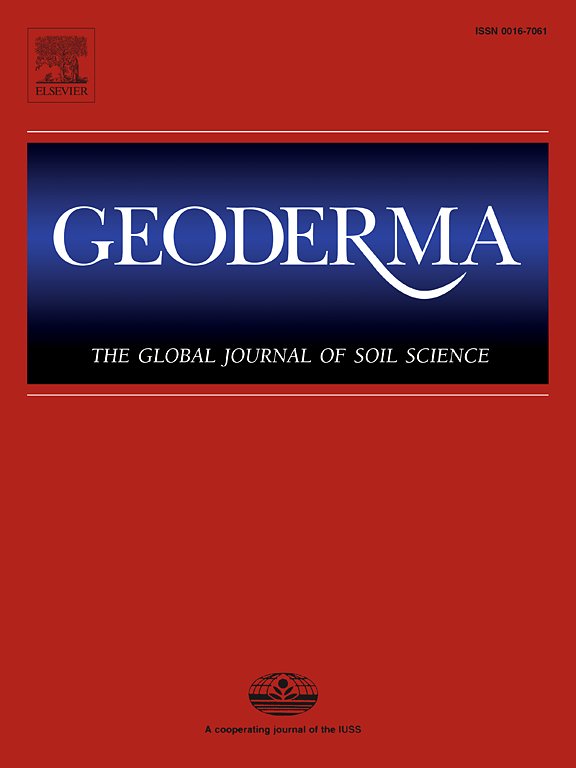Effects of tree fall on soil Collembola: Disentangling the role of gap formation and deadwood addition
IF 5.6
1区 农林科学
Q1 SOIL SCIENCE
引用次数: 0
Abstract
Increased frequency of climate extremes causes large scale forest decline associated with gap formation and input of deadwood to the forest floor, which largely changes soil systems. However, for disentangling the effects of gap formation and deadwood addition, experimental manipulations allowing to separate the effects of each are needed. Based on a large-scale full-factorial forest gap and deadwood addition experiment, we analyzed the response of soil invertebrates (Collembola) to gap formation and deadwood addition across three geographical regions in Germany i.e., the Alb, Hainich and Schorfheide. Both gap formation and deadwood addition altered the taxonomic richness, density and traits of Collembola communities. The effects of gap formation and deadwood addition were independent of each other but varied among regions, reflecting the importance of both geographic and historical context, as well as environmental changes such as variations in climate. Gap formation strongly decreased total density of Collembola in the Hainich but increased it in the Schorfheide, indicating that the effect is negative in regions with high precipitation and deep soils but positive in regions with low precipitation and shallow soils. Deadwood addition little affected Collembola density but restructured the community composition and increased overall functional and species taxonomic richness, presumably by expanding niche space by increased habitat heterogeneity. Gap formation filtered for small-sized and soil-living species via decreased soil moisture, but did not affect other traits such as number of ocelli and reproduction mode. The results suggest that gap formation and deadwood addition affect Collembola communities and traits in an independent way. Overall, the results indicate that deadwood is pivotal for soil diversity conservation, and forest gaps detrimentally affect animals deeper in soil being adapted to moist conditions.
树木砍伐对土壤弹线虫的影响:林隙形成和枯木添加的作用
极端气候频率的增加导致与林隙形成和枯木进入森林地面有关的大规模森林衰退,这在很大程度上改变了土壤系统。然而,为了解开间隙形成和枯木添加的影响,需要实验操作来分离每种影响。通过大规模全因子森林林隙和枯枝加成试验,分析了德国Alb、Hainich和Schorfheide 3个地理区域土壤无脊椎动物(Collembola)对林隙形成和枯枝加成的响应。林隙形成和枯木添加都改变了线虫群落的丰富度、密度和性状。林隙形成和枯木添加的影响是相互独立的,但在不同区域之间存在差异,反映了地理和历史背景以及气候变化等环境变化的重要性。林隙的形成强烈地降低了海地线虫的总密度,而增加了海地线虫的总密度,表明这种影响在高降水和深土壤地区是负的,而在低降水和浅土壤地区是正的。添加枯木对线虫密度影响不大,但通过增加生境异质性扩大生态位空间,重构群落结构,提高群落整体功能和物种分类丰富度。土壤湿度的降低对小型和土生物种有过滤作用,但对其他性状如单眼数量和繁殖方式没有影响。结果表明,林隙形成和枯枝添加对弹线虫群落和性状的影响是独立的。总体而言,研究结果表明,枯木对土壤多样性保护至关重要,森林林隙不利于土壤深处的动物适应潮湿条件。
本文章由计算机程序翻译,如有差异,请以英文原文为准。
求助全文
约1分钟内获得全文
求助全文
来源期刊

Geoderma
农林科学-土壤科学
CiteScore
11.80
自引率
6.60%
发文量
597
审稿时长
58 days
期刊介绍:
Geoderma - the global journal of soil science - welcomes authors, readers and soil research from all parts of the world, encourages worldwide soil studies, and embraces all aspects of soil science and its associated pedagogy. The journal particularly welcomes interdisciplinary work focusing on dynamic soil processes and functions across space and time.
 求助内容:
求助内容: 应助结果提醒方式:
应助结果提醒方式:


